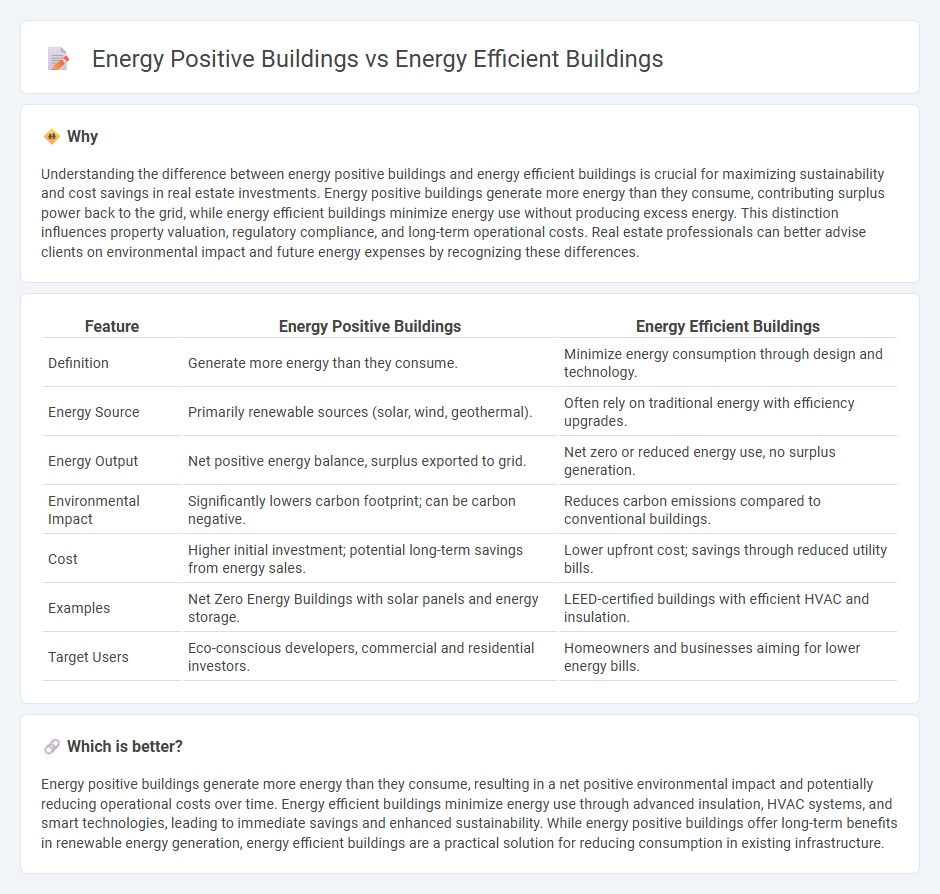
Energy positive buildings generate more energy than they consume, often through renewable sources like solar panels, while energy efficient buildings focus on reducing energy consumption through advanced insulation and smart technologies. This distinction highlights the shift from merely minimizing energy use to actively producing surplus energy for sustainability. Explore how these innovative approaches are transforming the future of real estate development.
Why it is important
Understanding the difference between energy positive buildings and energy efficient buildings is crucial for maximizing sustainability and cost savings in real estate investments. Energy positive buildings generate more energy than they consume, contributing surplus power back to the grid, while energy efficient buildings minimize energy use without producing excess energy. This distinction influences property valuation, regulatory compliance, and long-term operational costs. Real estate professionals can better advise clients on environmental impact and future energy expenses by recognizing these differences.
Comparison Table
| Feature | Energy Positive Buildings | Energy Efficient Buildings |
|---|---|---|
| Definition | Generate more energy than they consume. | Minimize energy consumption through design and technology. |
| Energy Source | Primarily renewable sources (solar, wind, geothermal). | Often rely on traditional energy with efficiency upgrades. |
| Energy Output | Net positive energy balance, surplus exported to grid. | Net zero or reduced energy use, no surplus generation. |
| Environmental Impact | Significantly lowers carbon footprint; can be carbon negative. | Reduces carbon emissions compared to conventional buildings. |
| Cost | Higher initial investment; potential long-term savings from energy sales. | Lower upfront cost; savings through reduced utility bills. |
| Examples | Net Zero Energy Buildings with solar panels and energy storage. | LEED-certified buildings with efficient HVAC and insulation. |
| Target Users | Eco-conscious developers, commercial and residential investors. | Homeowners and businesses aiming for lower energy bills. |
Which is better?
Energy positive buildings generate more energy than they consume, resulting in a net positive environmental impact and potentially reducing operational costs over time. Energy efficient buildings minimize energy use through advanced insulation, HVAC systems, and smart technologies, leading to immediate savings and enhanced sustainability. While energy positive buildings offer long-term benefits in renewable energy generation, energy efficient buildings are a practical solution for reducing consumption in existing infrastructure.
Connection
Energy positive buildings generate more energy than they consume, contributing surplus power back to the grid, while energy efficient buildings minimize energy consumption through advanced insulation, smart systems, and sustainable materials. Both concepts share the goal of reducing environmental impact by optimizing energy use and integrating renewable energy technologies such as solar panels and geothermal systems. The synergy between energy positive and energy efficient designs advances sustainable real estate development by lowering operational costs and enhancing property value.
Key Terms
Energy Consumption
Energy efficient buildings minimize energy consumption through advanced insulation, smart HVAC systems, and energy-saving technologies, significantly reducing the carbon footprint. Energy positive buildings not only consume less energy but also generate surplus energy via renewable sources like solar panels and wind turbines, contributing excess power back to the grid. Explore how cutting-edge innovations in these building types transform energy consumption and sustainability goals.
Net Energy Production
Energy efficient buildings reduce energy consumption through advanced insulation, smart HVAC systems, and LED lighting, minimizing reliance on external power sources. Energy positive buildings, however, generate more energy than they consume by integrating renewable technologies such as solar panels and wind turbines, achieving net energy production above zero. Explore how these innovative building types contribute to sustainable urban development and energy independence.
Sustainability
Energy efficient buildings prioritize reducing energy consumption through advanced insulation, efficient HVAC systems, and smart design to minimize environmental impact. Energy positive buildings go beyond efficiency by generating more energy than they consume, using renewable energy sources like solar panels or wind turbines, contributing significantly to sustainability goals. Explore how these building types transform the future of sustainable architecture and urban planning.
Source and External Links
19 Critical Features for Energy Efficient Buildings - Energy-efficient buildings use a whole-building approach including continuous insulation, high-efficiency heating and cooling systems, insulated foundations, and ENERGY STAR(r) electronics to reduce energy use and costs while improving comfort and sustainability.
What are energy efficient buildings - Energy efficient buildings minimize energy consumption by using sustainable materials, high-performance insulation, energy-efficient windows, advanced HVAC systems, and renewable technologies like solar panels to achieve long-term cost savings and environmental benefits.
Buildings - Energy System - IEA - Buildings account for over one third of global energy use and emissions; energy efficient and zero-carbon-ready buildings need strong policies, technological advances, and investments to shape a sustainable future and achieve net-zero emissions by 2050.
 dowidth.com
dowidth.com